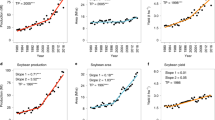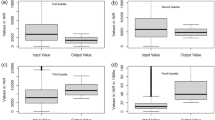Abstract
Animal manure used to be the major source of additional nutrients and crucial for maintaining soil fertility and crop yield in traditional farming systems. However, it is increasingly not recycled, wasting vital resources and damaging the environment. By using long-term (1986–2017) data from a rural household survey (>20,000 households) across China, here we show that the share of rural households with both crop planting and livestock raising (CPLR) has sharply declined from 71% in 1986 to only 12% in 2017. Compared with households with only crop planting, the CPLR households apply less synthetic fertilizer and more manure per cropland area. However, manure production in one-third of CPLR households has exceeded the nutrient requirement of crop growth on their croplands. Rebuilding the links between livestock and croplands at a regional scale thus provides vital opportunities for the sustainable intensification of agriculture in China.
This is a preview of subscription content, access via your institution
Access options
Access Nature and 54 other Nature Portfolio journals
Get Nature+, our best-value online-access subscription
$29.99 / 30 days
cancel any time
Subscribe to this journal
Receive 12 digital issues and online access to articles
$119.00 per year
only $9.92 per issue
Buy this article
- Purchase on Springer Link
- Instant access to full article PDF
Prices may be subject to local taxes which are calculated during checkout





Similar content being viewed by others
Data availability
Data of the main findings can be found in the Supplementary Information, and any further data that support the findings of this study are collated from literature sources as cited or available from the corresponding author upon reasonable request. Source data are provided with this paper.
References
Griggs, D. et al. Sustainable development goals for people and planet. Nature 495, 305–307 (2013).
FAOSTAT: FAO Statistical Databases (FAO, 2020).
Bai, Z. et al. China’s livestock transition: driving forces, impacts, and consequences. Sci. Adv. 4, r8534 (2018).
Oenema, O. Nitrogen budgets and losses in livestock systems. Int. Congr. Ser. 1293, 262–271 (2006).
Sutton, M. A. et al. Our Nutrient World: The Challenge to Produce More Food and Energy with Less Pollution (Centre for Ecology and Hydrology, 2013).
van Grinsven, H. J. M. et al. Reducing external costs of nitrogen pollution by relocation of pig production between regions in the European Union. Reg. Environ. Change 18, 2403–2415 (2018).
Sutton, M. A. et al. Too much of a good thing. Nature 472, 159–161 (2011).
Gu, B., Zhang, X., Bai, X., Fu, B. & Chen, D. Four steps to food security for swelling cities. Nature 566, 31–33 (2019).
Zhang, C. et al. Rebuilding the linkage between livestock and cropland to mitigate agricultural pollution in China. Resour. Conserv Recycl. 144, 65–73 (2019).
Gu, B., Ju, X., Chang, S. X., Ge, Y. & Chang, J. Nitrogen use efficiencies in Chinese agricultural systems and implications for food security and environmental protection. Reg. Environ. Change 17, 1217–1227 (2017).
Gu, B., Ju, X., Chang, J., Ge, Y. & Vitousek, P. M. Integrated reactive nitrogen budgets and future trends in China. Proc. Natl Acad. Sci. USA 112, 8792–8797 (2015).
Ma, L. et al. Exploring future food provision scenarios for China. Environ. Sci. Technol. 53, 1385–1393 (2018).
Wu, Y. et al. Policy distortions, farm size, and the overuse of agricultural chemicals in China. Proc. Natl Acad. Sci. USA 115, 7010–7015 (2018).
Ju, X., Gu, B., Wu, Y. & Galloway, J. N. Reducing China’s fertilizer use by increasing farm size. Glob. Environ. Change 41, 26–32 (2016).
Fan, L. et al. Decreasing farm number benefits the mitigation of agricultural non-point source pollution in China. Environ. Sci. Pollut. Res. Int. 26, 464–472 (2019).
Naylor, R. Losing the links between livestock and land. Science 310, 1621–1622 (2005).
Willems, J. et al. Why Danish pig farms have far more land and pigs than Dutch farms? Implications for feed supply, manure recycling and production costs. Agric. Syst. 144, 122–132 (2016).
Garnier, J. et al. Reconnecting crop and cattle farming to reduce nitrogen losses to river water of an intensive agricultural catchment (Seine basin, France): past, present and future. Environ. Sci. Policy 63, 76–90 (2016).
National Data (National Bureau of China, 2019).
Bai, X., Shi, P. & Liu, Y. Society: realizing China’s urban dream. Nature 509, 158–160 (2014).
Zheng, C., Liu, Y., Bluemling, B., Mol, A. P. J. & Chen, J. Environmental potentials of policy instruments to mitigate nutrient emissions in Chinese livestock production. Sci. Total Environ. 502, 149–156 (2015).
Cui, Z. et al. Pursuing sustainable productivity with millions of smallholder farmers. Nature 555, 363–366 (2018).
Bai, Z. et al. China’s pig relocation in balance. Nat. Sustain. 2, 888 (2019).
Zhang, X. et al. Managing nitrogen for sustainable development. Nature 528, 51–59 (2015).
van Grinsven, H. J. M. et al. Costs and benefits of nitrogen for Europe and implications for mitigation. Environ. Sci. Technol. 47, 3571–3579 (2013).
Oenema, O. et al. in The European Nitrogen Assessment: Sources, Effects and Policy Perspectives (eds M. A. Sutton et al.) 62–81 (Cambridge Univ. Press, 2011).
The Technical Guidelines for Measuring the Bearing Capacity of Soil Contaminated by Livestock and Poultry Manure (Ministry of Agriculture and Rural Affairs of the People’s Republic of China, 2018).
Gu, B. et al. Toward a generic analytical framework for sustainable nitrogen management: application for China. Environ. Sci. Technol. 53, 1109–1118 (2019).
Acknowledgements
This study was supported by the National Key Research and Development Project of China (2016YFD0201304, 2018YFC0213300), National Natural Science Foundation of China (41822701 and 41773068), National Social Fund of China (18ZD48) and the Fundamental Research Funds for the Central Universities (2019XZZX004-11). S.R.’s contribution was supported by the UK Natural Environment Research Council (NERC) National Capability programme SUNRISE (NE/R000131/1).
Author information
Authors and Affiliations
Contributions
S.J. and B.G. designed the study. B.W. prepared the data. B.Z., Y.H., C.R., C.Z. and B.G. analysed the data and prepared the figures. B.G. wrote the paper, and S.R. revised the paper. All authors contributed to discussing the results and writing the manuscript.
Corresponding authors
Ethics declarations
Competing interests
The authors declare no competing interests.
Additional information
Publisher’s note Springer Nature remains neutral with regard to jurisdictional claims in published maps and institutional affiliations.
Extended data
Extended Data Fig. 1 Locations of the selected villages of the Fixed Observation Rural Survey (FORS).
Base map produced using GADM data (https://gadm.org/).
Extended Data Fig. 2 Locations of the selected counties of Fixed Observation Rural Survey (FORS).
Base map produced using GADM data (https://gadm.org/).
Extended Data Fig. 3 Examples of daily account.
The daily account of rural household on all their production and consumption activities related to agriculture.
Extended Data Fig. 4 The proportion of household and industrial livestock farming systems in 2010s.
a, production proportion; b, farm number proportion. Fixed Observation Rural Survey (FORS) normally can cover household livestock farms, but not industrial farms which are operated by independent companies. But due to the number of industrial farms is less than 1% of total livestock farms in China, normally not survey but statistical counting of industrial farms is used.
Extended Data Fig. 5 Spatial variations of manure and machinery use in all surveyed villages in 2017 across China.
a, manure share in crop-only households; b, manure share in Crop planting and livestock raising (CPLR) households; c, machinery use in crop-only households; d, machinery use in CPLR households. Base map produced using GADM data (https://gadm.org/).
Extended Data Fig. 6 Temporal changes of fertilizer use in Crop only and CPLR households.
a, application rates of synthetic phosphorus (P) fertilizer; b, application rates of synthetic P fertilizer in Crop planting and livestock raising (CPLR) households with different livestock density; c, application rates of synthetic potassium (K) fertilizer; b, application rates of synthetic K fertilizer in CPLR households with different livestock density. Crop - only crop planting; Livestock - only livestock raising; CPLR - crop planting and livestock raising; <15, 15-30, 30-75 and >75 refer to livestock raising density with pig equivalent per ha cropland in CPLR households. Error bars refer to standard errors (SEs).
Supplementary information
Supplementary Information
Supplementary methods and Table 1.
Source data
Source Data Fig. 2
Statistical source data.
Source Data Fig. 3
Statistical source data.
Source Data Fig. 4
Statistical source data.
Source Data Extended Data Fig. 4
Statistical source data.
Source Data Extended Data Fig. 6
Statistical source data.
Rights and permissions
About this article
Cite this article
Jin, S., Zhang, B., Wu, B. et al. Decoupling livestock and crop production at the household level in China. Nat Sustain 4, 48–55 (2021). https://doi.org/10.1038/s41893-020-00596-0
Received:
Accepted:
Published:
Issue Date:
DOI: https://doi.org/10.1038/s41893-020-00596-0
This article is cited by
-
Managing urban development could halve nitrogen pollution in China
Nature Communications (2024)
-
Ageing threatens sustainability of smallholder farming in China
Nature (2023)
-
Comprehensive assessment of the utilization of manure in China’s croplands based on national farmer survey data
Scientific Data (2023)
-
Nutrient management in China at the crossroads
Nutrient Cycling in Agroecosystems (2023)
-
Identification of livestock farms with potential risk of environmental pollution by using a model for returning livestock manure to cultivated land
Environmental Science and Pollution Research (2023)



